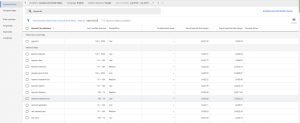

GET MARKETING INSIGHTS TO GROW YOUR AMAZON BUSINESS
– MARKET SHARE
– COMPETITOR INSIGHTS
– PRODUCT CATEGORY POTENTIAL & A LOT MORE!
SEO for eCommerce: How to Optimize Your Product Descriptions


As an online seller, you could have the best product in the world – but if your shoppers can’t find it, they can’t make a purchase.
How do you ensure your shoppers can find your products online? The key to unlocking that ever-important question is Search Engine Optimization (SEO). While the world of SEO encompasses multiple tools, tasks and specialist-level knowledge, there are changes you can make within your customer-facing product content that will satisfy SEO requirements and help boost your search engine ranking.
The very first step in optimizing your product content is to ensure you have well-written copy that is helpful to those reading it. With that as a baseline, you can then incorporate the following techniques to take your content to the next level.
1. Know Your Audience


A key step in writing product descriptions that are optimized for search is to ensure you’re using language that is relevant to the people most likely to search for your product. Determine not only who your audience is in general, but find out:
- Their gender
- Their age
- Where they live
- Where they shop
- Where they search
Is your target shopper well-versed in industry jargon, or should your content appeal to people with a wider range of knowledge on the topic? A good thing to remember is that the person purchasing your product might not always be the one to use it – so if you’re selling electrical equipment to homeowners, or nail polish to husbands on Valentine’s Day, make sure the content you present can be understood by those shoppers, too.
2. Perform Keyword Research
Once you know and understand your target audience, it is important to find out what exactly it is they are searching for when looking for your product. There are many tools available online that will help you do just that, including Google’s Keyword Planner and the Amazon-specific MerchantWords.
While each keyword finder tool you come across online will work slightly differently, the goal is the same: look up your product type and receive a list of relevant, high-volume keywords actual shoppers are using to find it.
Once you have determined your list of valuable keywords and key-phrases, it’s time to incorporate them into your product description writing. Be careful not to list or overuse keywords (called “keyword stuffing”) as this will actually hurt your organic ranking. Weave keywords and phrases into your copy in a way that sounds natural for the best results.


3. Write Unique Content
Most of us were taught in school that plagiarism is wrong. This still rings true, especially when it comes to SEO for eCommerce. Plagiarism can be detrimental to your organic ranking, because search engines prefer – and actually reward – content that is unique. While you may use trendy industry language or information about similar products for inspiration, your product description must always be unique.
If you’re selling a product that is also sold elsewhere online, the features and specifications will stay the same. The way you describe those features and specifications, your long description, and any narrative copy you weave into your content should be unique to your listing.


4. Make Use of Headers
Keywords hold greater weight within headers than in body text, so it’s important to make use of header tags within your product content when applicable. This is more difficult for brands selling on a marketplace, but if you’re creating your own product listings on your eCommerce website, it definitely presents an opportunity to bring in more traffic.
Introduce new features and benefits with headers or use them to preface supplementary content (for example, you can showcase recipes on a food product’s listing, or a tutorial on the page for a beauty product).
5. Create Meta Data and Alt Tags
In addition to traditional customer-facing content, there are two areas that often slip the minds of eCommerce sellers: meta data and alt tags. Meta data is a short set of content that provides information about what’s on a webpage. When you search for something on Google, what you see in the results (a title and description for the page) is meta data. Don’t let Google decide what content to show in these areas – write your own based on your brand and product language.
Alt tags are written descriptions for images on a page. You can easily optimize your commercial product photography for search by writing these descriptive tags. Alt tags help people who may be visually impaired and who rely on screen-reading technology to understand the many images available on a website. Search engines give credit to websites leveraging alt tags, as they add another layer of helpfulness and accessibility.
6. Consider Additional Content Opportunities
In addition to having well-written, optimized product descriptions, search engines like Google reward websites that deliver new content on a regular basis. If you run your own eCommerce website, consider additional content opportunities, including:
- Blogs
- Recipes
- Tutorials/Instructions
- Video content
- A collection of news mentions/PR
Optimizing your product listing copy and ensuring you have a steady stream of new content on a regular basis will set your brand up for search success.



